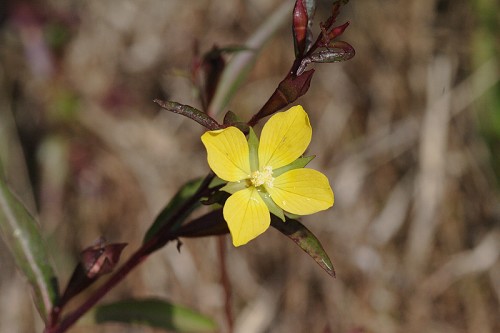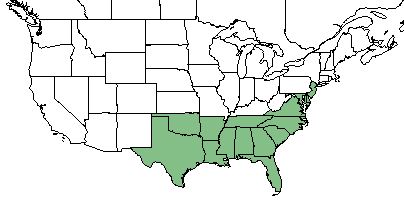Difference between revisions of "Ludwigia linearis"
Emmazeitler (talk | contribs) (→Taxonomic Notes) |
Emmazeitler (talk | contribs) (→Distribution) |
||
| Line 28: | Line 28: | ||
==Distribution== | ==Distribution== | ||
| − | ''L. linearis'' | + | ''L. linearis var. linearis'' ranges from southern New Jersey to central peninsular Florida, west to southeastern Louisiana, and inland to the Cumberland Plateau of northcentral Alabama and central Tennessee.<ref name="weakley">Weakley, A.S. 2015. Flora of the southern and mid-atlantic states. Working Draft of 21 May 2015. University of North Carolina at Chapel Hill, Chapel Hill, North Carolina.</ref> ''L. linearis var. puberula'' ranges from central Alabama to central Arizona and eastern Missouri, south to eastern Texas, and north to Florida and North Carolina.<ref name="weakley">Weakley, A.S. 2015. Flora of the southern and mid-atlantic states. Working Draft of 21 May 2015. University of North Carolina at Chapel Hill, Chapel Hill, North Carolina.</ref> |
==Ecology== | ==Ecology== | ||
Revision as of 19:16, 25 September 2020
Common name: narrowleaf primrose-willow [1], eastern narrowleaf seedbox [2]
| Ludwigia linearis | |
|---|---|

| |
| Photo by the Southeastern Flora Database | |
| Scientific classification | |
| Kingdom: | Plantae |
| Division: | Magnoliophyta - Flowering plants |
| Class: | Magnoliopsida - Dicots |
| Order: | Myrtales |
| Family: | Onagraceae |
| Genus: | Ludwigia |
| Species: | L. linearis |
| Binomial name | |
| Ludwigia linearis Walter | |

| |
| Natural range of Ludwigia linearis from USDA NRCS Plants Database. | |
Contents
Taxonomic Notes
Synonyms: none.[3]
Varieties: Ludwigia linearis Walter var. linearis, Ludwigia linearis Walter var. puberula Engelmann & A. Gray.[3]
Description
L. linearis is a perennial forb/herb of the Onagraceae family native to North America. [1]
Distribution
L. linearis var. linearis ranges from southern New Jersey to central peninsular Florida, west to southeastern Louisiana, and inland to the Cumberland Plateau of northcentral Alabama and central Tennessee.[3] L. linearis var. puberula ranges from central Alabama to central Arizona and eastern Missouri, south to eastern Texas, and north to Florida and North Carolina.[3]
Ecology
Habitat
L. linearis proliferates in savannas and interdunal swales. [2] Specimens have been collected from shallow water of pond, longleaf pine flatwoods, moist sandy loam of roadside, cypress swamp, black sandy peat, wiregrass wet pine flatwoods, wet savanna, and sandy clay of cleared loblolly pine flat. [4]
Ludwigia linearis is an indicator species for the Peninsula Savannas community type as described in Carr et al. (2010).[5]
Phenology
L. linearis has been observed flowering July through October. [6]
Conservation and Management
Cultivation and restoration
Photo Gallery
References and notes
- ↑ 1.0 1.1 USDA Plant Database https://plants.usda.gov/core/profile?symbol=LULI
- ↑ 2.0 2.1 Weakley, A. S. (2015). Flora of the Southern and Mid-Atlantic States. Chapel Hill, NC, University of North Carolina Herbarium.
- ↑ 3.0 3.1 3.2 3.3 Weakley, A.S. 2015. Flora of the southern and mid-atlantic states. Working Draft of 21 May 2015. University of North Carolina at Chapel Hill, Chapel Hill, North Carolina.
- ↑ URL: http://herbarium.bio.fsu.edu. Last accessed: June 2018. Collectors: Loran C. Anderson, Nancy E. Jordan, Cecil Slaughter, Marc Minno, Ann F. Johnson, Neal Morar, R.K. Godfrey, O. Lakela, R. Kral, Sidney McDaniel, Richard Houk, Bruce Hansen, JoAnn Hansen, A.H. Curtiss, R. Komarek, Annie Schmidt. States and counties: Florida (Nassau, Liberty, Franklin, Clay, Escambia, Washington, Wakulla, Dixie, Hillsborough, Taylor, Leon, Jefferson, Hamilton, Gulf, Calhoun, Santa Rosa, Okaloosa, Walton, Jackson, Gadsden, Calhoun, Bay) Georgia (Seminole, Thomas, Atkinson) Alabama (Mobile) Texas (Orange) Arkansas (Calhoun)
- ↑ Carr, S.C., K.M. Robertson, and R.K. Peet. 2010. A vegetation classification of fire-dependent pinelands of Florida. Castanea 75:153-189.
- ↑ Nelson, G. PanFlora: Plant data for the eastern United States with emphasis on the Southeastern Coastal Plains, Florida, and the Florida Panhandle. www.gilnelson.com/PanFlora/ Accessed: 24 MAY 2018